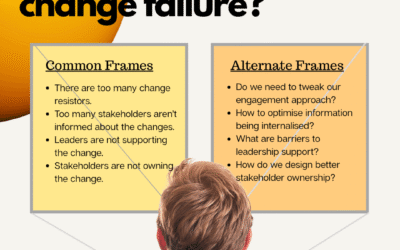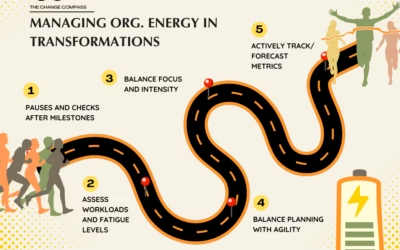Most seasoned executives will agree that implementing a strategy can be a lot more complex and challenging than the formulation of the strategy. If you read articles on strategy implementation you will find a myriad of factors to keep focused on including resourcing, prioritisation, tracking, program management, etc.
However, the one discipline that is under-leveraged in strategy execution is change management. You may ask why? A lot of change managers are hired to focus on one specific projects, whether it be rolling out a new system or introducing a new product. Many understand the skill set of change managers as focusing on developing communication and training plans.
When we look deeper into what is needed to successfully implement a strategy and the work approach of a change manager, you will see that there is significant synergy. Change management is also concerned with planning and managing not just one but a multiple of changes. In fact, best practice companies use a portfolio approach to manage a suite of changes.
Here are some of the ways in which change management naturally complements strategy implementation:
Change vision
One of the most critical parts of implementing a strategy is how we bring stakeholders along the journey. Typically, senior managers will ‘dream up’ the strategy in a closed room, and then try to roll this out to the rest of the organization. Alternatively, a consulting firm may be hired to design a strategy that may stay on the shelf and never becomes implemented.
The change manager’s approach is to design the strategy formulation process by bringing concerned stakeholder groups together to build consensus and buy-in. The classic change commitment curve shows that the more you involve someone throughout the process, the more they will develop a sense of ownership and feel that it is in their interest to make the change successful.
A typical change management approach would also encompass clarifying the ‘what’ and the ‘why’ of the strategy in a way that makes sense to the audience. Is the end state clear? What is the role of each stakeholder in making this a success? How do we position the end state so that it arouses the ‘head’ as well as the ‘heart’ so that people can connect to it? Connecting to people emotionally is key to engagement.
Understanding the impacts of the change
A strategy usually involves a set of initiatives or changes that the business would like to focus on to achieve their goals. A lot of organizations jump straight into planning and implementing the various initiatives before understanding what the total impact is on the various parts of the business, and the impacts on the customer.
Having an integrated view of what the impacts will mean to each part of the organization is key. This integrated picture can be leveraged to provide a clear, cohesive and integrated set of messages and expectations to that part of the organization that will guide their change process. And depending on the change, what the Marketing department will focus on may be completely different compared to the Human Resource department. Having an integrated picture means that we are able to help employee join the dots around what the strategy and the various initiatives mean to them, versus just a set of independent projects. In this way, creating meaning for the overall change helps with engagement.
The change manager’s approach would be to focus on mapping on the various impacts on stakeholder groups, including the customer. The impacts would consist of people and organization impacts, process impacts, and technology impacts. In this way, we are able to understand and architect what changes we are making across the board before we begin the journey. This will also ensure effective sequencing, prioritization and alignment before jumping into initiative delivery.

Capabilities required to support the strategy
A typical change approach would involve looking at the capabilities required to support the strategy. A big part of change management work is analysing the requirements of implementing the change (in this case a set of initiatives to support the strategy), and formulating key capabilities required. Capabilities may be developed using a range of approaches, including hiring functional specialists, conducting learning sessions, or coaching. The Change Manager will formulate learning needs analysis, and then formulate appropriate learning interventions. For significant capability development programs, competencies frameworks may need to be set up.
Capabilities may need to be acquired rather than developed. In this case the change manager would look at how to ensure that the talent acquired can fit in smoothly in the current culture of the organization. Team development sessions may need to be conducted. This includes whether the capability is acquired through acquisition, or key talents were hired into the organization.
Engagement and communication
Ineffective engagement and communication can make or break a strategy. A significant portion of strategy implementation needs to be spent on engagement with every layer of the stakeholder impacted. Change impacts conducted will help to inform what kind of engagement is required with what stakeholder group. This includes the severity of the impact, the duration of the impact, why the stakeholders may be concerned, and how critical they are to the success of the strategy, etc.
The change manager will then design the right governance processes to ensure that key stakeholders are in the loop and embedded within the decision-making process. In addition to this, the change manager will craft a communications plan to target various stakeholder groups, with targeted messages, and using a mix of communication channels to get the message across. An effective communication approach would also include designing the right feedback mechanisms to ensure employee feedback is proactively incorporated.
Measurement
A key success criterion for implementing a strategy is measuring the progress of implementation to understand where the organization is at. It is common for change managers to devise change readiness assessments to measure and test where each part of the business is at. These assessments are conducted throughout the implementation period to understand any changes in readiness and track overall progress. The assessment can in the form of interviews, surveys or ratings by selected stakeholders. Other measurements include training attendance, competency attainment, and communication effectiveness of various channels utilised.
The most important part of charting the implementation of the strategy is measuring the impact of the change. Best practice calls for detailed capturing of change impacts on each part of the organization in a visual way to aid understanding. This includes heatmaps and reports on what the implementation roadmap will mean to the business. The change impact based heatmaps are critical to allow effective planning to balance the need to drive the strategy forward, and balance the business-as-usual activities so that the business is still able to perform.
Effective reporting should call out resourcing impacts, whether there is too much going on from a rollout perspective, potential re-sequencing opportunities, and the overall pace of change within the implementation roadmap. The data should enable effective conversations in terms of how effective the planned roadmap is in reaching strategy objectives and whether the right pace and velocity of change are being planned.

Change leadership
Last but not least driving an effective strategy requires effective leadership skills. The work of the change manager involves assessing existing leadership qualities, including understanding any gaps and challenges. These may be addressed by capability programs.
The change manager also normally takes in working with the sponsor of the change, in this case it could be a member of the c-suite on his or her change leadership skills. Some examples of effective skills include the ability to articulate the end state in a way that the audience can relate to and be enthusiastic about, ability t listen and empathise with employee groups, ability to identify and resolve any change obstacles, the ability sense check and pivot as needed (agility), and the ability to delegate and hold others accountable for achieving prescribed targets.
– Analyse change impacts to the whole system: people, process, technology.
– Map out the impacts of current and planned strategies to better sequence and plan the change
– Look at the capabilities required in the business
– Engagement and communications, involving key players in developing the strategy
– Measurement – business readiness and indicator tracking
– Change leadership is driving traction and behaviour change
– A strategy contains a set of initiatives – the key is to formulate a picture of what will be changing and be able to sequence and prioritise things to design the roadmap effectively
———————–
If you like this article please share this with your network.






